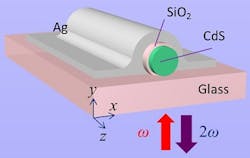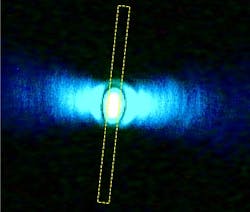Nanowire inside a nanocavity efficiently frequency-doubles light
(Image: University of Pennsylvania)
University of Pennsylvania (Philadelphia, PA) scientists have placed cadmium sulfide (CdS) nanowires in silver nanocavities to produce nanoscopic nonlinear second-harmonic-generation optical devices; the silver nanocavities boost the efficiency of the nonlinear process (frequency-doubling 950 nm to 475 nm) by more than a factor of 1000.1 The nanoscopic devices use their cavities' lowest-order whispering gallery mode to concentrate the light, while minimizing losses.
The output of the CdS frequency-doubling nanowire is then funneled into a waveguide that serves as a configurable optical router. The assembly could potentially be used in integrated nanophotonic systems as a tunable coherent light source.
The study was led by Ritesh Agarwal, professor of materials science and engineering in Penn’s School of Engineering and Applied Science, and Ming-Liang Ren, a postdoctoral researcher in his lab. Other members of the Agarwal lab, Wenjing Liu, Carlos O. Aspetti and Liaoxin Sun, contributed to the study.
"Mixing two input signals to get a new output is the basis of computation," says Agarwal. "It’s easy to do with electric signals, but it's not easy to do with light, as light waves don’t normally interact with one another."
Pre-existing nonlinear materials have not been viable for computational applications due to high power and large volume constraints. "A nonlinear material, such as cadmium sulfide, can change the frequency, and thus the color, of light that passes through it," says Ren, "but you need a powerful laser, and, even so, the material needs to be a many micrometers and even up to millimeters thick. That doesn't work for a computer chip."
| Light is emitted from the underside of the silver nanocavity. The dotted outline shows the orientation of the cadmium sulfide nanowire. (Image: University of Pennsylvania) |
"The frequency-changing efficiency of cadmium sulfide is intrinsic to the material, but it depends on the volume of the material the wave passes through," says Agarwal. "By adding the silver shell, we can significantly decrease the volume needed to get a usable signal and push the device size into the nanoscale."
The research was supported by the U.S. Army Research Office, National Institutes of Health and Air Force Office of Scientific Research.
Source: http://www.upenn.edu/pennnews/news/penn-engineers-efficiently-mix-light-nanoscale
REFERENCE:
1. Ming-Liang Ren et al., Nature Communications (2014); doi: 10.1038/ncomms6432

